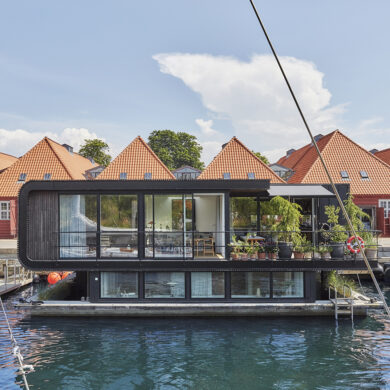Lykke: A Kitchen of Love
Thomas Lykke and Garde Hvalsøe have a shared passion for materials and bespoke solutions of sublime quality and have created several exceptional projects together. Our latest design is a modular cabinetmaker’s kitchen – originally created for the designer’s classic Copenhagen flat as a timeless love story about classic craftsmanship, contrasts and music.
Details
Case
Type
Model
Material


“Wood is special. You have to understand its nature, and it is important to remember that the tree grew for twenty, fifty, sometimes hundreds of years to produce the wood for my cabinetmaker’s kitchen.”
Thomas Lykke grew up with a grandfather who was a cabinetmaker, and he spent much of his childhood with him in the workshop, where he learned about the nature and characteristics of wood. That led to a life-long love of wood as a unique material to be designed and crafted with respect.
‘Wood is special. You have to understand its nature, and it is important to remember that the tree grew for twenty, fifty, sometimes hundreds of years to produce the wood for my cabinetmaker’s kitchen,’ says Thomas Lykke, who has been running OEO Studio together with Anne-Marie Buemann since 2003 and has a strong bond with Japan, a country that also has strong craft traditions.

OEO Studio’s intuitive approach to materials, rooms and people combined with a warm, minimalist aesthetic has taken the design studio around the world. OEO Studio has revitalized international brands and given shape to everything from showrooms to design products for leading manufacturers – and the Danish design studio chooses its cooperation partners carefully.
The creative partnership between OEO Studio and Garde Hvalsøe is rooted in the love of wood and other materials that grow more beautiful with age and in a shared uncompromising dedication to integrity and quality. Over the years, this has resulted in outstanding architecture and interior design projects, from the Kadeau restaurant and Dinesen’s award-winning showroom in the heart of Copenhagen to an exclusive kitchen for the flower artist Nicolai Bergmann in his home in the mountains outside Tokyo.


“The design of the piece is an example of “form follows function”, and every single detail.”
When Thomas Lykke needed a new kitchen for his own home, a historical flat from 1896 in the heart of Copenhagen’s Østerbro district, it was obvious for him to partner up with Garde Hvalsøe to create a kitchen with a timeless expression and materiality.
The occasion for the new design was the addition of a balcony with access via two double doors from the kitchen, where oblique angles and lines are part of the charm. The inspiration came from the world of music and art, in the form of a showpiece that OEO Studio and Garde Hvalsøe created together for the Wallpaper* Handmade X exhibition in 2019.
‘Our contribution was the “Cabinet of Love”, a piece of furniture that celebrates sublime craftsmanship and slow living by providing a setting for the analogue ritual of playing vinyl records and listening to music. The design of the piece is an example of “form follows function”, and every single detail is the result of careful consideration,’ says Thomas Lykke.
‘Cabinet of Love’ was an obvious starting point, and the outcome is a beautiful cabinetmaker’s kitchen imbued with the same love of craftsmanship and functionality. A Kitchen of Love.


“I consider the kitchen a piece of furniture – it has to be durable, functional, beautiful and, not least, engaging. It was important for me to create a celebration of the classic, timeless expression.”
‘I consider the kitchen a piece of furniture – it has to be durable, functional, beautiful and, not least, engaging. It was important for me to create a celebration of the classic, timeless expression with subtle details and contrast that highlight both materials and composition,’ says Thomas Lykke. The design is called the Lykke Model and is made to order by Garde Hvalsøe.
The details lend the kitchen its unique personality, as wood meets metal and marble. The kitchen attains an almost floating expression with a metal plinth that strikes a contrast to the solid-wood body. The metal is also used in slender vertical divisions wherever cabinets are placed side by side. The metal features not only highlight the lines but also underscore the inherent beauty of the different materials. The marble tabletop takes on an elegant and similarly floating appearance thanks to its slightly raised position and the use of a shadow-groove trim. The visible finger joints complete the impression of a classic cabinetmaker’s kitchen in a modern interpretation.

Unlike a traditional cabinetmaker’s kitchen, the Lykke model is modular, which provides a high degree of flexibility in installations. That allowed Thomas Lykke to create the large kitchen island in between the balcony doors that flood the room with light and had a clear impact on the design of the kitchen.
All elements in the kitchen are testimony to the love of classic craftsmanship and materials. The ceramic pieces were handmade on the Danish island of Bornholm. The knives were bought on a visit to the old Tsukiji fish market in Tokyo. The brass tea caddy comes from the Japanese firm Kaikado, where craft techniques have been handed down through six generations.
Some objects play a role in the common rituals of everyday life, others are on display for their beauty and warmth. And music remains a key ingredient, as it accompanies all cooking in this cabinetmaker’s kitchen.







